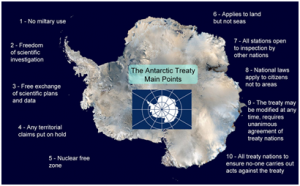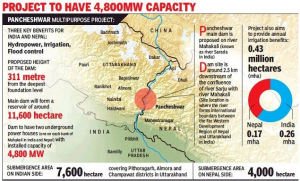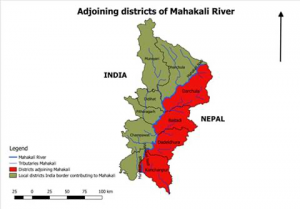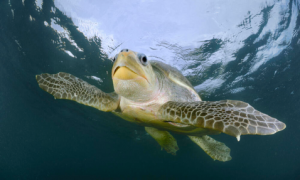THE POLITY AND GOVERNANCE
1. INDIAN ANTARCTIC BILL, 2022
THE CONTEXT: The Indian Antarctic Bill, 2022, introduced in Lok Sabha is pursuant to India’s accession to Antarctic Treaty, 1959 as well as the Protocol on Environment Protection (Madrid Protocol) to the Antarctic Treaty.
THE EXPLANATION:
Indian Antarctic Bill will also be useful in building credibility and enhancing the status of the country globally.
Objective:
- The Indian Antarctic Bill, 2022 introduced in Lok Sabha aims at providing national measures to protect the Antarctic environment, and the dependent and associated ecosystems.
- The Indian Antarctic Bill also aims to give effect to the Antarctic treaty, 1959, the protocol on the Environmental Protection to the Antarctic Treaty, 1998, and the Convention on the Conservation of Antarctic Marine Living Resources, 1982
- The latest bill also aims at promoting Antarctica as a natural reserve that is devoted to science and peace and to ensure that the Antarctic does not become the scene of international discord.
About India’s expedition to Antarctic
- The Indian Antarctic Programme is a multi-institutional, multi-disciplinary programme. It is under the control of the National Centre for Polar and Ocean Research, Ministry of Earth Sciences, Government of India.
- The Indian Antarctic Programme was initiated in 1981 with the first Indian expedition to Antarctica.
- It further gained global acceptance with India’s signing of the Antarctic Treaty as well as the construction of the Dakshin Gangotri Antarctic research base in 1983 which was superseded by the Maitri base from 1989.
- In 2012, the newest Bharati base was commissioned which was constructed out of 134 shipping containers.
- Under India’s Antarctic Programme, biological, earth, atmospheric, medical sciences, and chemical are studied in India. The country has carried out 30 scientific expeditions to the Antarctic as of October 14, 2010.
Value addition:
The Antarctic Treaty
- The Antarctic Treaty was signed in Washington on 1 December 1959 by the twelve nations (Argentina, Australia, Belgium, Chile, France, Japan, New Zealand, Norway, South Africa, United Kingdom, United States and USSR).
- The Treaty now has 52 signatories. India became a member of this treaty in 1983.
- Headquarters: Buenos Aires, Argentina.
- The Treaty, applies to the area south of 60° South latitude.
Provisions:
- Antarctica shall be used for peaceful purposes only(Art. I).
- Freedom of scientific investigation in Antarctica and cooperation toward that end shall continue(Art. II).
- Scientific observations and results from Antarctica shall be exchanged and made freely available(Art. III).
- Article IV effectively seeks to neutralise territorial sovereignty in Antarctica.
- The treaty also put a freeze on any disputes between claimants over their territories on the continent.

| Antarctic Treaty System:
· As disputes have arisen over the years, many have been addressed through the expansion of the treaty framework with these agreements. This framework is now referred to as the “Antarctic Treaty System”. The Antarctic Treaty system is made up of four major international agreements: · The 1959 Antarctic Treaty. · The 1972 Convention for the Conservation of Antarctic Seals. · The 1980 Convention on the Conservation of Antarctic Marine Living Resources. · The 1991 Protocol on Environmental Protection to the Antarctic Treaty. |
THE INTERNATIONAL RELATIONS
2. EXPLAINED: WHY INDIA’S PACT WITH SRI LANKA ON A MARITIME RESCUE CENTRE IS SIGNIFICANT
THE CONTEXT: The agreement appears to be part of India’s SAGAR (Security and Growth for all in the Region) initiative in the Indian Ocean, which has also seen India, Sri Lanka, and the Maldives give a new push to their 2011 Colombo Security Conclave that now includes Mauritius.
THE EXPLANATION:
- India and Sri Lanka have signed a Memorandum of Understanding for the Indian public sector Bharat Electronics Ltd (BEL) to set up a state-of-the-art Maritime Rescue Co-ordination Centre (MRCC) in Colombo.
- The agreement is significant as it enhances co-operation on maritime security between the two countries in a part of the Indian Ocean region where the India-China rivalry has taken centre stage over the last decade. Earlier this month, India also provided a naval floating dock to the Sri Lankan Navy, and two Dornier aircraft to the Sri Lankan Air Force.
- According to senior officials, the engagement between the forces of the two countries will augment interoperability and seamless maritime actions like carrying out anti-smuggling operations in the Indian Ocean Region.
Enhancing Sri Lanka capacity
- MRCCs are part of an international network under the UN’s International Maritime Organisation to monitor the sea lanes with the objective of swift response to emergencies, such as vessels in distress, rescue and evacuation of people, and prevention of and containing environmental disasters such as oil spills.
- Each country is responsible for its own Search and Rescue Region. The work of MRCCs is co-ordinated by the Navy or Coast Guard in each country. In India, the Coast Guard is the co-ordinating agency. In Sri Lanka, it is the Navy.
- The Bengaluru-based BEL has proposed enhancing Sri Lanka’s small MRCC by setting up advanced software systems that will increase Sri Lanka’s capacities for communication and co-ordination in its SRR (Search and Rescue Region) in the Indian Ocean, where it is the first responder. The MRCC will be established with a grant of $6 million from India.
- The enhanced MRCC will work out of the Sri Lankan Navy headquarters at Colombo, with a sub-center at Hambantota, where a Chinese state-owned company runs a deep water port that it helped to the bill, and which was controversially leased to it by Sri Lanka in 2016.
- Seven other sub-units along Sri Lanka’s coastline will make up the proposed new network. In situations in which regional assistance has to be mobilised, as happened with the two recent ship fires in Sri Lankan waters, this MRCC will be able to share information with its Indian counterparts.
SAGAR push
- Sri Lanka’s SRR is a wide swathe of 1,778,062. 24 sq km of the Indian Ocean and nearly 200 ships pass through these waters every day.
- The agreement appears to be part of India’s SAGAR (Security and Growth for all in the Region) initiative in the Indian Ocean, which has also seen India, Sri Lanka and Maldives give a new push to their 2011 Colombo Security Conclave that now includes Mauritius.
- The recent meeting of the CSC National Security Advisers identified “five pillars” of co-operation: maritime safety and security; countering terrorism and radicalisation; combating trafficking and transnational organised crime; cyber security, protection of critical infrastructure and technology; and humanitarian assistance and disaster relief.
THE ENVIRONMENT, ECOLOGY, AND CLIMATE CHANGE
3. RECORD NESTING OF OLIVE RIDLEY TURTLES
THE CONTEXT: As a record number of 4.92 lakh Olive Ridley turtles have crawled to the Rushikulya coast in Odisha, scientists have tagged more than 6,000 turtles to gather more information about their breeding behaviour and migration.
THE EXPLANATION:
- Odisha is the largest mass nesting site for Oliver Ridleys in the world. As temperatures start rising and getting warmer, the mass nesting season for Olive Ridley turtles on the Odisha coast starts. Lakhs of Olive Ridley sea turtles have flocked this year to Rushikulya river mouth for their annual mass nesting.
- These species flock to the place every year from the third week of February to the first week of March for nesting. After a long journey, all the way from the Indian Ocean, the turtles take a rest for some days after burying the eggs.
- According to the officials,This increased to 4.92 lakhs at Rushikulya and 5.20 lakhs at Gahirmatha.
- Arribada is a Spanish word meaning “arrival by sea” and refers to the mass nesting behaviour exhibited by Kemp’s Ridley and Olive Ridley sea turtles.
Value Addition:
Olive Ridley Sea Turtles
Olive Ridley Turtles (Lepidochelys olivacea) are migratory species visiting Indian coasts for nesting.
- These turtles travel all the way from the South Pacific Ocean to breed on the coast of Gahirmatha. Their mass nesting phenomenon is called arribadas.

- IUCN Status: Vulnerable; CITES: APPENDIX 1
- They have the highest degree of protection as they are included in Schedule-I of the Wildlife (Protection) Act, 1972.
- The turtle eggs normally take 45 days to hatch. After this, tiny hatchlings come out and make their way to the sea.
- Threats: Heavy predation of eggs by dogs and wild animals, indiscriminate fishing with trawlers and gill nets, and beach soil erosion.
- Every year, the Indian Coast Guard’s “Operation Olivia”, initiated in the early 1980s, helps protect Olive Ridley turtles as they congregate along the Odisha coast for breeding and nesting from November to December.
- KURMA App: It is aimed at turtle conservation by providing users with a database to identify a species but also provides the location of the nearest rescue centre for turtles across the country.
Developed by: The application has been developed by the Indian Turtle Conservation Action Network(ITCAN) in collaboration with the Turtle Survival Alliance-India and Wildlife Conservation Society-India.
THE SCIENCE AND TECHNOLOGY
4. ISRO TO STEP UP TRACKING OF SPACE DEBRIS
THE CONTEXT: ISRO is building up its orbital debris tracking capability by deploying new radars and optical telescopes under the Network for Space Objects Tracking and Analysis (NETRA) project.
THE EXPLANATION:
Tracking of space debris:
- A space debris tracking radar with a range of 1,500 km and an optical telescope will be inducted as part of establishing an effective surveillance and tracking network under NETRA.
- The government has given the go-ahead for the deployment of the radar, which will be capable of detecting and tracking objects 10 cm and above in size, he said.
- It will be indigenously designed and built.
- Radars and optical telescopes are vital ground-based facilities for keeping an eye on space objects, including orbital junk.
- Space junk or debris consists of spent rocket stages, dead satellites, fragments of space objects and debris resulting from ASAT.
- Hurtling at an average speed of 27,000 kmph in LEO, these objects pose a very real threat as collisions involving even centimetre-sized fragments can be lethal to satellites.
- For protecting its space assets, ISRO was forced to perform 19 collision avoidance manoeuvres (CAM) in 2021, of which 14 were in Low Earth Orbit (LEO) and five in the geostationary orbit. The number of CAMs jumped from just three in 2015 to 12 in 2020 and 19 in 2021.
About Network for Space Objects Tracking and Analysis (NETRA) project:
- Project NETRA is an early warning system in space to detect debris and other hazards to Indian satellites.
- ISRO SSA Control Centre, “NETRA”, is now set up within the ISTRAC campus at Peenya, Bangalore.
- NETRA’s eventual goal is to capture the GEO, or geostationary orbit, the scene at 36,000 km where communication satellites operate.
- Under NETRA, or Network for space object Tracking and Analysis, the ISRO plans to put up many observational facilities:
-
- connected radars, telescopes
- data processing units
- a control centre
- They can, among others, spot, track and catalogue objects as small as 10 cm, up to a range of 3,400 km and equal to a space orbit of around 2,000 km.
THE PRELIMS PERSPECTIVE
5. PANCHESHWAR MULTIPURPOSE PROJECT
THE CONTEXT: During his upcoming visit, Nepal’s Prime Minister is expected to focus on his personal experience of handling India-Nepal relations over Pancheshwar Multipurpose Project.

THE EXPLANATION:
- In India and Nepal, the proposed catchment area for the water is expected to submerge a total of 11600 hectares of land (7600 hectares in India and 4000 hectares in Nepal).
- This mega dam (Pancheshwar) will be built upon the Mahakali river (known in India as Sharada) which originates in Nepal and flows through Uttarakhand where various tributaries like Dhauli, Gori, Sarayu and Ramganga feed the Mahakali. Upon completion, this dam, the biggest in South Asia, is expected to generate 6480 MW of power, and will service both India and Nepal, besides controlling floods and decreasing the fear of drought.
IMPORTANCE:
- Nepal shares a border with 5 Indian states- Uttarakhand, Uttar Pradesh, West Bengal, Sikkim and Bihar. Hence an important point of cultural and economic exchange.
- Importance for India can be studied from two different angles: a) their strategic importance for India’s national security; and b) their place in India’s role perception in international politics.
- Nepal is right in the middle of India’s ‘Himalayan frontiers’, and along with Bhutan, it acts as northern ‘borderland’ flanks and acts as buffer states against any possible aggression from China.
- The two countries not only share an open border and unhindered movement of people, but they also have close bonds through marriages and familial ties, popularly known as Roti-Beti ka Rishta.
- India is Nepal’s largest trade partner and the largest source of foreign investments, besides providing transit for almost the entire third-country trade of Nepal.
- Indian firms engaged in manufacturing, services (banking, insurance, dry port), power sector and tourism industries etc.

THE PRELIMS PRACTICE QUESTIONS
QUESTION OF THE DAY
Q1. Consider the following statements about Olive Ridley Turtles:
- They are migratory species visiting Indian coasts for nesting.
- Their mass nesting phenomenon is called arribadas.
- Their IUCN conservation status is endangered.
Which of the statements given above is/are correct?
a) 1 only
b) 1 and 2 only
c) 2 and 3 only
d) 1, 2 and 3
ANSWER FOR 1ST APRIL 2022
Answer: B
Explanation:
- Statement 1 is incorrect: Koodiyattam is a traditional performing art form in the state of Kerala, India.
- Statement 2 is correct: It is a combination of ancient Sanskrit theatre with elements of Koothu, an ancient performing art from the Sangam era.
- Statement 3 is correct: It is officially recognized by UNESCO as a Masterpiece of the Oral and Intangible Heritage of Humanity.
Spread the Word


